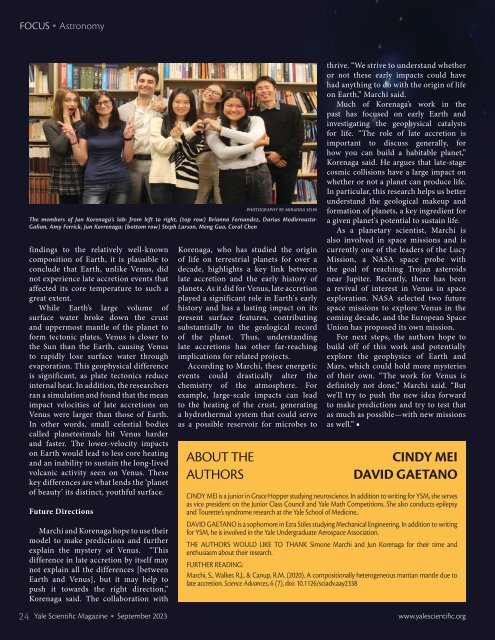YSM Issue 96.3
Create successful ePaper yourself
Turn your PDF publications into a flip-book with our unique Google optimized e-Paper software.
FOCUS<br />
Astronomy<br />
findings to the relatively well-known<br />
composition of Earth, it is plausible to<br />
conclude that Earth, unlike Venus, did<br />
not experience late accretion events that<br />
affected its core temperature to such a<br />
great extent.<br />
While Earth’s large volume of<br />
surface water broke down the crust<br />
and uppermost mantle of the planet to<br />
form tectonic plates, Venus is closer to<br />
the Sun than the Earth, causing Venus<br />
to rapidly lose surface water through<br />
evaporation. This geophysical difference<br />
is significant, as plate tectonics reduce<br />
internal heat. In addition, the researchers<br />
ran a simulation and found that the mean<br />
impact velocities of late accretions on<br />
Venus were larger than those of Earth.<br />
In other words, small celestial bodies<br />
called planetesimals hit Venus harder<br />
and faster. The lower-velocity impacts<br />
on Earth would lead to less core heating<br />
and an inability to sustain the long-lived<br />
volcanic activity seen on Venus. These<br />
key differences are what lends the ‘planet<br />
of beauty’ its distinct, youthful surface.<br />
Future Directions<br />
Marchi and Korenaga hope to use their<br />
model to make predictions and further<br />
explain the mystery of Venus. “This<br />
difference in late accretion by itself may<br />
not explain all the differences [between<br />
Earth and Venus], but it may help to<br />
push it towards the right direction,”<br />
Korenaga said. The collaboration with<br />
Korenaga, who has studied the origin<br />
of life on terrestrial planets for over a<br />
decade, highlights a key link between<br />
late accretion and the early history of<br />
planets. As it did for Venus, late accretion<br />
played a significant role in Earth's early<br />
history and has a lasting impact on its<br />
present surface features, contributing<br />
substantially to the geological record<br />
of the planet. Thus, understanding<br />
late accretions has other far-reaching<br />
implications for related projects.<br />
According to Marchi, these energetic<br />
events could drastically alter the<br />
chemistry of the atmosphere. For<br />
example, large-scale impacts can lead<br />
to the heating of the crust, generating<br />
a hydrothermal system that could serve<br />
as a possible reservoir for microbes to<br />
ABOUT THE<br />
AUTHORS<br />
PHOTOGRAPHY BY MIRANDA SELIN<br />
The members of Jun Korenaga’s lab: from left to right, (top row) Brianna Fernandez, Darius Modirrousta-<br />
Galian, Amy Ferrick, Jun Korrenaga; (bottom row) Steph Larson, Meng Guo, Coral Chen<br />
thrive. “We strive to understand whether<br />
or not these early impacts could have<br />
had anything to do with the origin of life<br />
on Earth,” Marchi said.<br />
Much of Korenaga’s work in the<br />
past has focused on early Earth and<br />
investigating the geophysical catalysts<br />
for life. “The role of late accretion is<br />
important to discuss generally, for<br />
how you can build a habitable planet,”<br />
Korenaga said. He argues that late-stage<br />
cosmic collisions have a large impact on<br />
whether or not a planet can produce life.<br />
In particular, this research helps us better<br />
understand the geological makeup and<br />
formation of planets, a key ingredient for<br />
a given planet's potential to sustain life.<br />
As a planetary scientist, Marchi is<br />
also involved in space missions and is<br />
currently one of the leaders of the Lucy<br />
Mission, a NASA space probe with<br />
the goal of reaching Trojan asteroids<br />
near Jupiter. Recently, there has been<br />
a revival of interest in Venus in space<br />
exploration. NASA selected two future<br />
space missions to explore Venus in the<br />
coming decade, and the European Space<br />
Union has proposed its own mission.<br />
For next steps, the authors hope to<br />
build off of this work and potentially<br />
explore the geophysics of Earth and<br />
Mars, which could hold more mysteries<br />
of their own. “The work for Venus is<br />
definitely not done,” Marchi said. “But<br />
we'll try to push the new idea forward<br />
to make predictions and try to test that<br />
as much as possible—with new missions<br />
as well.” ■<br />
CINDY MEI<br />
DAVID GAETANO<br />
CINDY MEI is a junior in Grace Hopper studying neuroscience. In addition to writing for <strong>YSM</strong>, she serves<br />
as vice president on the Junior Class Council and Yale Math Competitions. She also conducts epilepsy<br />
and Tourette’s syndrome research at the Yale School of Medicine..<br />
DAVID GAETANO is a sophomore in Ezra Stiles studying Mechanical Engineering. In addition to writing<br />
for <strong>YSM</strong>, he is involved in the Yale Undergraduate Aerospace Association.<br />
THE AUTHORS WOULD LIKE TO THANK Simone Marchi and Jun Korenaga for their time and<br />
enthusiasm about their research.<br />
FURTHER READING:<br />
Marchi, S., Walker, R.J., & Canup, R.M. (2020). A compositionally heterogeneous martian mantle due to<br />
late accretion. Science Advances, 6 (7), doi: 10.1126/sciadv.aay2338<br />
24 Yale Scientific Magazine September 2023 www.yalescientific.org

















